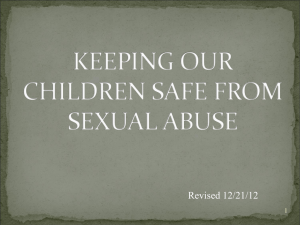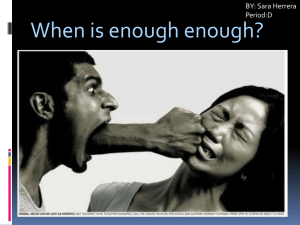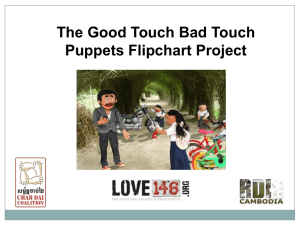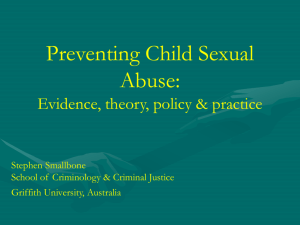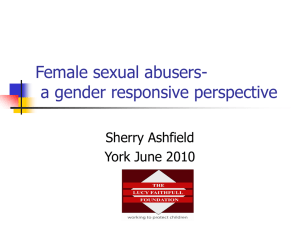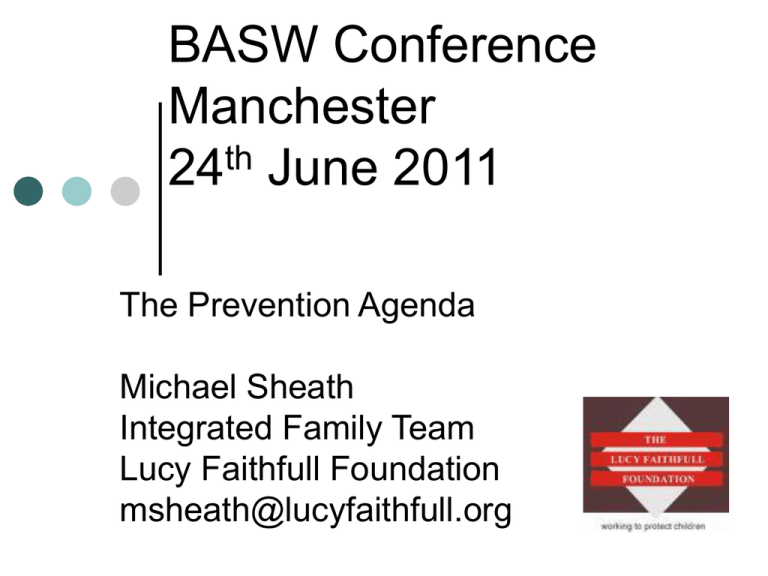
BASW Conference
Manchester
th
24 June 2011
The Prevention Agenda
Michael Sheath
Integrated Family Team
Lucy Faithfull Foundation
msheath@lucyfaithfull.org
The ‘Reactive’ agenda
An experience of sexual abuse, for a child:
A)
B)
C)
Tends to be traumatic, intrusive, and
shameful
Tends to be an experience beyond the
child’s understanding and recall
In most cases, will have followed a
process of grooming
Finkelhor: ‘Traumagenic
Dynamics’
Premature Sexualisation
The victim learns to associate sex (and
possibly arousal) with fear, reward, shame,
care, love, punishment, etc
Stigma
The victim feels shame and guilt in respect of
their experience
Finkelhor: ‘Traumagenic
Dynamics’
Betrayal
The victim feels an acute sense of betrayal at
having a loved and trusted person take
advantage of that role
Powerlessness
The victim feels an acute sense of their own
lack of potency, in that their will has been
overcome or subverted
Potential consequences for
victims
Premature Sexualisation
Confusion around the meaning and purpose of
sex: associations with prostitution, promiscuity,
risk taking, arousal problems
Stigma
Viewing the self and sex as shameful and ‘dirty.’
Carrying the guilt and responsibility that belongs
to the perpetrator
Potential consequences for
victims
Betrayal
Difficulties in trust, especially in intimate
relationships, and respect, especially in regard
to ‘authority’ figures
Powerlessness
Problems with efficacy and self esteem,
depression, fatalism
Grooming includes:
The provision of gifts, attention, love,
affection.
The creation of secrets, dependency,
confusion, and ambivalence
The use of seduction
The goal of compliance
The sharing and transmission of distortions
and blame, resulting in implanted thinking
errors
Disclosure is easier
contemplated than done:
How does a child disclose to a parent who is
married to the perpetrator ?
How does a child disclose to a parent who is
the parent of the perpetrator ?
How does a child disclose against a perpetrator
the parents are in awe of ?
How does a child disclose against a perpetrator
who is loved, feared, or depended upon?
Consequently…
How do we expect traumatised, confused,
dependent, fearful, powerless, shamed,
untrusting children……..
to find the courage and coherence to make and
sustain allegations against an adult, or even
another child, in the face of predictable denials
and predictably unhelpful dynamics?
Why is it, that:
1 in 6 women, and 1 in 10 men experience
sexual abuse in childhood
‘Typical’ sexual abuse takes place over a
period of more than 12 months
80% of children who are sexually abused
do not inform the authorities
95% of allegations made to the authorities
do not result in criminal convictions
Issues
Global,
national, and personal ignorance
about the nature of sexual offending
against children
Denial, and what flows from it
‘Noise’, and trauma in the communities
we work with
Ignorance
We persist in the notion that children are molested by
strangers, and that their molestation is invariably
violent
We fail to register the proportion of children who are
abused by their peers
We remain oblivious to the nature of molestation by
women
We stereotype child molesters as ‘paedophiles’ and
monsters
In doing so we leave children vulnerable to assaults
by friends and family, children and adolescents,
women, and nice heterosexual men
Denial:
a definition
“ A normal and functional defence
mechanism that allows us to
protect ourselves against
something that is painful and
distressing”
(American Psychiatric Association, 1994)
Denial
Confronting the reality of child molestation
requires us to accept some painful home truths:
the domestic nature of our abuse
the difficulties in identifying and prosecuting
offenders
the commoditisation of sex, and the
objectification of women and children
the sexualisation of youth
the ubiquity of pornography and abusive
imagery
Trauma, and ‘noise’
Significant proportions of the people we
work with have experience of:
Childhood abuse: physical, sexual,
emotional, and neglect
Residential care
Attachment difficulties
Learning difficulties
Domestic and sexual violence
Trauma creates ‘noise’
‘Noise’ consists of pre existing views,
schema and prejudices, which act as a filter
upon ‘new’ information and perspectives.
The manifestations of noise are often seen
as deliberate resistance, although it usually
operates and influences at a pre conscious
level.
The origins of noise usually reside in trauma:
trauma does not necessarily lead to insight
Examples
A woman with a history of domestic violence
may be less able to develop an awareness of
sexual risk.
Someone who experiences severe sexual
abuse in childhood may look upon less
intrusive sexual abuse as trivial
Someone who has been successfully groomed
will have adopted a number of distortions
about their own responsibility for the abuse:
they ‘deserved’, ‘wanted’, ‘enjoyed’ it: they
may well ascribe these ideas to other victims.
Implications
Perpetrators are often extremely astute in
respect of their ability to identify and exploit
trauma and noise in the women and
families they target
They often create dependency and
confusion in both mother and children,
including targeted and non targeted
children
So…
If our society remains ignorant about the
realities of child sexual abuse
If we remain in denial about the true nature of
our offenders
If our prejudices and personal feelings interfere
with a meaningful engagement with the problem
We will leave responsibility for reporting,
identifying and apprehending abusers with the
children who are abused by them: this is at the
heart of the reactive agenda
We need to understand the
process of sexual abuse,
So that we can identify the process of abuse,
interfere in the process of abuse, and prevent
the process of abuse
The Prevention Agenda
Primary prevention: Avoids the
development of sexual abuse in our
communities
Secondary Prevention: Detects problematic
behaviours, and offers opportunities for
early intervention
Tertiary Prevention: Responds to identified
abuse and abusers, and seeks to prevent
its recurrence, or minimise its impact
The Prevention Agenda
Primary
prevention
Offenders
Victims
Situations
Communities
Secondary
prevention
Tertiary
prevention
Primary Prevention for
offenders:
Developmental prevention: Domestic
violence reduction, reducing domestic
consumption of pornography
Education on boundaries, relationships,
sexuality etc
Safeguarding via vetting, safer recruitment,
ROSHOs, etc
Secondary Prevention for
Offenders:
Confidential Helplines (Stop it Now!)
Counselling for at-risk individuals
Intercepting attempts to view abusive imagery
Identification of worrying behaviours in
children, and treatment thereafter
Tertiary Prevention for
Offenders:
Prisons/Special Hospitals
SOPOs
Offender treatment programmes
Management in the community (MAPPA)
Circles of Support and Accountability
Stop It Now!
Targets: –
Adult abusers and potential abusers: to encourage
them to recognise their behaviour as abusive and
seek help to change.
Family and friends: to encourage them to
recognise the signs of abusive behaviour in those
close to them and to seek advice about what
action to take.
Parents of children and young people with
worrying sexually behaviour : to encourage them
to recognise signs of abusive behaviour in their
children and seek advice about what to do.


